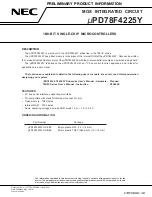
26 LCD CONTROLLER (LCDC)
26-14
Seiko Epson Corporation
S1C33L26 TECHNICAL MANUAL
FPSHIFT_POL = 0
FPSHIFT_MSK = 0
FPSHIFT_POL = 1
FPSHIFT_MSK = 0
FPSHIFT_POL = 0
FPSHIFT_MSK = 1
FPSHIFT_POL = 1
FPSHIFT_MSK = 1
FPDAT[23:0]
TFT_CTL3 (SPL)
FPSHIFT (DCLK)
D1
D2
D3
D319 D320
5.3.4 FPSHIFT (DCLK) Variations
Figure 26.
TFT_CTL1 (CLS) pulse start/stop offset
The TFT_CTL1 (CLS) pulse position and width can be specified in pixel clock cycles. Use CTL1ST[9:0]/
LCDC_TFT_CTL1 register to set the pulse start position and CTL1STP[9:0]/LCDC_TFT_CTL1 register to set
the pulse stop position. These values should be specified an offset from the FPLINE pulse start position.
By setting this register, the TFT_CTL1 pulse width is set to CTL1STP[9:0] - CTL1ST[9:0] + 1 [Ts].
To program the TFT_CTL1 pulse, CTL1CTL/LCDC_TFTSO register and CTLCNT_RUN/LCDC_TFTSO reg-
ister must be set to 1.
When CTL1CTL is set to 0 (default), the TFT_CTL1 pulse is toggled at the FPLINE pulse start edge.
The TFT_CTL1 and TFT_CTL0 signals can be swapped using CTL01SWAP/LCDC_TFTSO register.
TFT_CTL1 pin: CLS output (CTL01SWAP = 0), PS output (CTL01SWAP = 1)
TFT_CTL0 pin: PS output (CTL01SWAP = 0), CLS output (CTL01SWAP = 1)
TFT_CTL0 (PS) pulse start/stop offset
The TFT_CTL0 (PS) pulse position and width can be specified in pixel clock cycles. Use CTL0ST[9:0]/
LCDC_TFT_CTL0 register to set the pulse start position and CTL0STP[9:0]/LCDC_TFT_CTL0 register to set
the pulse stop position. These values should be specified an offset from the FPLINE pulse start position.
By setting this register, the TFT_CTL0 pulse width is set to CTL0STP[9:0] - CTL0ST[9:0] + 1 [Ts].
To program the TFT_CTL0 pulse, CTLCNT_RUN must be set to 1.
The TFT_CTL1 and TFT_CTL0 signals can be swapped using CTL01SWAP.
TFT_CTL2 (REV) delay
Use CTL2DLY[9:0]/LCDC_TFT_CTL2 register to set the TFT_CTL2 toggle edge delay time from the FPLINE
pulse start edge. To program the TFT_CTL2 delay time, CTLCNT_RUN must be set to 1.
Display Modes
26.5.4
By setting the LCDC_DISPMOD register, a display mode (color/mono, use of LUT) and a bpp mode (color depth
or gray levels) can be selected according to the LCD panel used as shown in Table 26.5.4.1.
5.4.1 LCD Panel Type and Display Mode
Table 26.
Panel
LCDC_DISPMOD register
Display mode
Available bpp mode
PANELSEL
COLOR
LUTPASS
Color/Mono
LUT
1
2
4
8
12
16
24
TFT panel
1
1
1
Color
Bypass
3
3
3
3
3
3
3
1
1
0
Color
LUTRAM
*
3
3
3
3
CSTN panel
0
1
1
Color
Bypass
3
3
3
3
3
3
0
1
0
Color
LUTRAM
*
3
3
3
3
MSTN panel
0
0
1
Monochrome
Bypass
3
3
3
0
0
0
Monochrome
MLUT
3
3
3
*
To use LUTRAM, DSTRAM_CFG/MISC_RAM_LOC register must be set to 1. However, set it to 0 when rewriting
LUTRAM.
















































